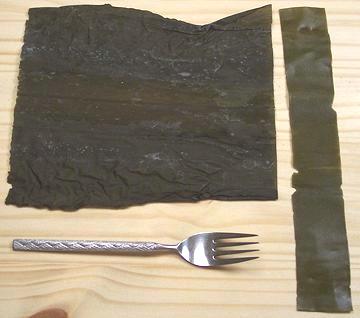 [Konbu, Kombu (Japan); Miyeok, Dashima (Korea); Haidai (China):
Laminaria japonica (and several other Laminaria species)]
[Konbu, Kombu (Japan); Miyeok, Dashima (Korea); Haidai (China):
Laminaria japonica (and several other Laminaria species)]
This is edible kelp grown along the coasts of Japan, Korea and China - quite different from the giant kelp of California which is processed rather than eaten directly. The long wide fronds are dried and packaged for use, particularly to make soup stock, but also for use as wrappers for various prepared foods. Almost all this kelp used for food is cultivated rather than gathered wild which explains why there are so few crunchy critters growing on it.
This kelp is normally sold as flat dried sheets cut from the fronds but is also sold as narrow cut strips, salted and bagged in the refrigerated section. In Japan it is also pickled and served as a snack to accompany green tea. The photo shows a piece of a frond as dried, and a shorter piece cut from the end after soaking.
More on Algae.
Kelp is very important to the cuisine of Japan, particularly for making soup stock, generally in combination with shaved bonito flakes or, for vegetarians, dried shiitake mushrooms. It is also very popular in Korea and to a much lesser extent in China. In Japan, many varieties are sold by name, each with very specific uses. Here in North America, we use the Kelp we can get, and have no hint what variety it is.
Keep the package sealed as much as possible and in a cool, dry place away from light and it will last a year or so.
Some more substantial recipes do call for strips of konbu to be cooked for a much longer time and eaten as part of the recipe. To prepare for cutting into strips, soak in cool water for about 1/2 hour.
al_konbuz 090201 - www.clovegarden.com